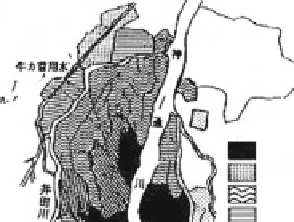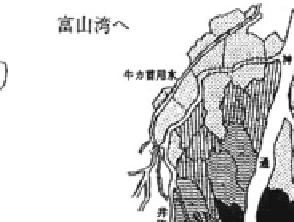Biomedical Engineering Reference
In-Depth Information
Jinzu River
Jinzu River
Toyama city
Toyama city
Cadmium pollution
Prevalence
Heavy pollution
≥
20 %
Moderate pollution
10
~
19%
5
~
9%
Mild pollution
Suspected pollution
< 5%
Nonpolluted area
0
Figure 8.2-6 The co-occurrence of cadmium contamination with the prevalence of itai itai disease in woman over fifty years of age in
Toyama Prefecture (c. 1961). Adapted from: Kanazawa Medicine, 1998.
Kamioka Mining Station of Mitsui Mining and Smelting
Co. Ltd was linked as the direct source of cadmium poi-
soning, and the Toyama Prefecture, 30 kilometers down-
stream, was designated the worst cadmium-contaminated
area (
Figure 8.2-6
). The concentrations of cadmium in
this prefecture were orders of magnitude higher than
that found in background levels and were well above
other industrialized locations (
Table 8.2-3
).
Cadmium exposure results in major health-related
problems of
itai itai
disease, irreversible kidney damage,
and bone disease (
itai itai
is Japanese for ''Ouch Ouch'').
After exposure to high levels of cadmium, the kidneys
have decreased ability to remove acids from the blood
due to proximal tubular dysfunction resulting in hypo-
phosphatemia (low-phosphate blood levels), gout (ar-
thritic disease), hyperuricemia (elevated uric acid levels
in the blood), hyperchloremia (elevated chloride blood
levels), and kidney atrophy (as much as 30%). Follow-
ing kidney dysfunction, victims of the disease develop
osteomalacia (soft bones), loss of bone mass, and osteo-
porosis leading to severe joint and back pains and in-
creased risk of fractures ATSDR (1999).
and governments have changed the health baseline of the
world. The background and baseline of contaminants in
the human body has increased dramatically in a relatively
short time (see
Ta b l e 8 . 2 - 3
). Theo Colburn, who is known
for her publications on the growth and effects of envi-
ronmental endocrine disrupting compounds, sums up the
problem of synthetic chemicals and the moral re-
sponsibility of corporations that gained much attention in
the 1960s and 1970s:
Every one of you sitting here today is carrying at least
500 measurable chemicals in your body that were never
in anybody's body before the 1920s.
.
We have dusted
the globe with man-made chemicals that can undermine
the development of the brain and behavior, and the
endocrine, immune and reproductive systems, vital
systems that assure perpetuity.
.
Everyone is exposed.
You are not exposed to one chemical at a time, but
a complex mixture of chemicals that changes day by
day, hour by hour, depending on where you are and the
environment you are in.
.
In the United States alone it
is estimated that over 72,000 different chemicals are
used regularly. Two thousand five hundred new
chemicals are introduced annually
d
and of these, only
15 are partially tested for their safety. Not one of the
chemicals in use today has been adequately tested for
these intergenerational effects that are initiated in the
womb.
35
Scale is more than size
As the previous cases indicate, the timing of exposure, not
just the amount of time, is of the essence. Corporations












